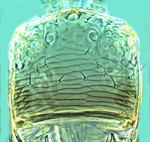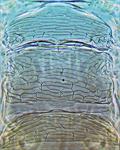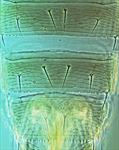
Antenna

Head (winged female)

Pronotum, mesonotum & metanotum (winged female)

Mesonotum, metanotum & tergite I (wingless female)

Tergites VI–VIII (winged female)

Tergites VII–VIII (wingless female)

Fore wing
Females usually without wings or ocelli, but sometimes both sexes fully winged. Body and legs yellow, distal antennal segments light brown. Antennae 9-segmented; sense cone simple on segment III, forked on IV. Head longer than wide, slightly overhanging bases of antennae; three pairs of ocellar setae present, pair III prominent; compound eyes with six pigmented ommatidia. Pronotum with one pair of prominent posteroangular setae. Mesonotum transverse, with group of about six small setae laterally in wingless form. Metanotum transverse, no campaniform sensilla. Abdominal tergites with transverse reticulation, median setae wide apart; tergite VIII with complete comb of short irregular microtrichia. Sternites without discal setae.
The genus Proscirtothrips includes only one species, although this has three junior synonyms. This has the general appearance of an Anaphothrips species, but with one pair of prominent pronotal posteroangular setae.
Probably associated with Poaceae, and presumably breeding on leaves.
Widespread in western USA, and recorded from California, Oregon, Arizona, Nevada, Utah, Idaho, and South Dakota.
THRIPIDAE - THRIPINAE
Proscirtothrips zeae (Moulton)
Anaphothrips zeae Moulton, 1911: 28
Anaphothrips longipennis Crawford DL, 1910: 150
Anaphothrips hesperus Moulton, 1911: 17
Scirtothrips crawfordi Priesner, 1932: 152 [replacement name]
Masumoto M & Okajima S (2017) Anaphothrips genus-group: key to world genera, with two new species and three new records from Japan (Thysanoptera, Thripidae). Zootaxa 4272(2): 201–220.